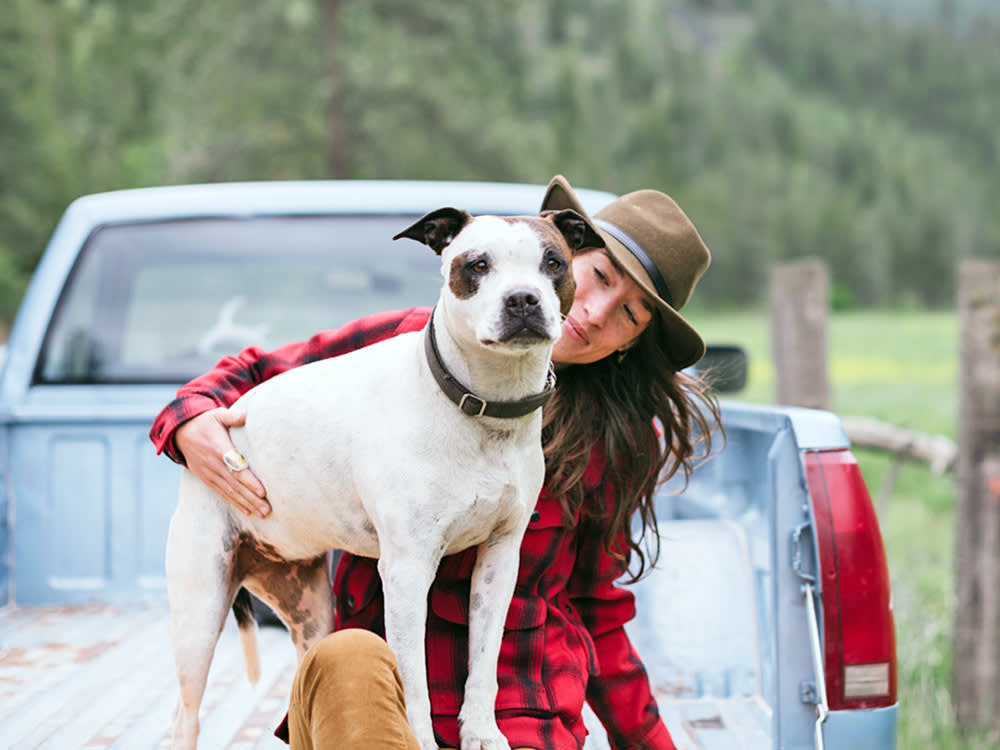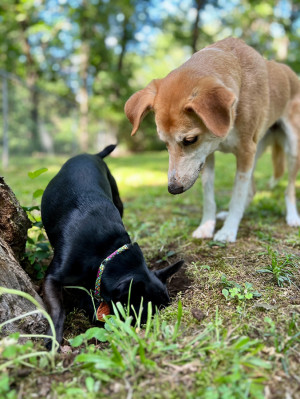How to Keep Flies Off Your Dog
Shoo, fly!

Share Article
In This Article:
Why Are Flies on My Dog? How To Keep Flies Off Dog What Repels Flies on Dogs? What Not To Do To Get Rid of Flies
Why some dogs (and people) are harassed by flies more than others is a bit of a mystery. There has been some speculation that certain blood types attract insects, but personal odor and skin microbiome seem to play roles as well. No matter the cause, flies are annoying and can transmit diseases to dogs. In some areas, it’s impossible to keep flies away completely, but there are some steps you can take to help protect your pup from these irritating insects.

Save on the litter with color-changing tech that helps you better care for your cat.
Why are flies on my dog?
“Every time we go outside, my dog gets swarmed with flies. They seem to be particularly attracted to his eyes and ears, but he hates that they’re constantly buzzing around his head and dive-bombing his face. I’d like to give him some relief, ideally using a natural repellent for flies on dogs. Is there anything available?”
Questions like this commonly come from dog parents in fly-prone regions of the country. Both biting and non-biting flies feed on dogs, so it’s no surprise that they’re excited to hop on as soon as your dog goes outside. Even though they’re small, flies can ruin your dog’s time outdoors. Biting flies cause pain as they pierce the skin to feed on blood. Non-biting flies don’t cause pain, but they irritate dogs as they swarm to feed on secretions from the eyes, nose, and mouth.
Although rare, flies have been found to carry diseases which can be transmitted to dogs, so it’s still worth finding ways to repel flies naturally or with medications. Keeping flies away from your dog results in increased comfort and a happier time outside.
Although disease-carrying biting flies are uncommon in most parts of the United States, it’s still worth finding ways to repel flies naturally or with medications. Keeping flies away from your dog results in increased comfort and a happier time outside.
How to keep flies off dogs
Because flies are a part of the ecosystem and don’t solely exist to bother your dog (though it may seem otherwise), eliminating them completely is impossible. There are steps you can take to help reduce your dog’s exposure to flies though. Some easy strategies you can employ include:
Avoiding walks at dawn and dusk
Flies are out in the largest numbers at dawn and dusk. If it’s safe for your dog, try to time walks during sunnier parts of the day when flies are least active. Obviously, this isn’t ideal for every situation: the dangers from the heat during a mid-summer walk in the middle of the day can outweigh the annoyance of flies at dusk.
Getting rid of standing water
Low spots in the lawn, clogged gutters, empty flower pots, and bird baths can all become breeding grounds for flies. If you’re having issues with flies swarming your dog every time they go in the yard, check the area for hazards like these.
Cleaning up your dog’s poop
Flies love poop. Even though it’s a pain, cleaning up poop every time your dog goes is a great way to cut down on fly populations. Leaving poop in the yard provides flies with both a place to lay eggs and a food source for their growing larvae.
Keeping trash secured
Anyone who has gotten a facefull of flies after tossing a bag into the trash bin knows that flies thrive on garbage. Put trash into bags and put the bags into a bin with a tight-fitting lid. Try to keep garbage cans away from areas that your dog frequents.
Bathing your dog regularly
Flies are attracted to organic debris, so a dirty dog makes for a more tempting target. This is especially true for long-haired dogs, who are more prone to having excess eye discharge and poop or pee stuck in their hair. Regular grooming and bathing is a good idea in general, and it can help keep flies away from your dog.
Washing your dog’s bedding
Bedding collects debris that can be tempting for flies. Keeping your dog’s bedding fresh can help to keep flies away, especially if some of their bedding is kept outdoors.
Waiting for windy days for longer walks
During particularly fly-heavy times of year, strategizing about when to walk may help to keep the flies away. It’s harder for flies to keep up their annoying habits in the face of a stiff breeze, so take the opportunity to enjoy a longer walk if it’s a windy day. (Be sure to keep your pup safe against any debris that may be flying around if it’s particularly windy; use your judgment).
What repels flies on dogs?
Finding a safe, effective way to keep flies off of dogs can be a challenge. There��’s a lot of online advice about what you can put on your dog to keep the flies off of them, but not a lot of solid data backing it up. Finding a good repellent for flies on dogs can be a challenge, so checking with your vet is a good idea. They may have recommendations for fly repellents that work well for the insects found in your area. Some common fly repellents include:
Pyrethrin and pyrethroids: These compounds are very effective insect repellents and can be found in both spot-on flea-and-tick medications and some topical ointments. Pyrethrin, a compound extracted from chrysanthemum plants, is a natural repellant for flies on dogs. Pyrethroids have a similar chemical structure to pyrethrins, helping them remain effective for a longer time. If you’re wondering how to keep flies off your dog’s ears, ointments containing these compounds are your best bet.
Adding a fan: If your dog hangs out on a covered porch or patio, adding an outdoor ceiling fan may create enough breeze to irritate flies and cause them to seek out another area. Of course, your dog has to appreciate being in the breezy area for this to work.
Fly traps: These can be an effective way to get rid of flies in enclosed spaces. There are many varieties available from home improvement stores that get rid of flies by using a sticky surface or one-way entrance to a container. While these traps may collect an impressive number of flies if put outside, they’re not particularly effective at reducing fly populations in the general environment.
Petroleum jelly: Although it isn’t an effective fly repellent, petroleum jelly can work well for some dogs who have issues with flies feeding on their ear tips. Coating the tips of your dog’s ears with a thin layer of Vaseline may provide enough of a barrier to prevent biting flies from feeding.
Always check with your vet before administering any new medications to your dog, even topical ones. They can help make sure there are no medication interactions or health issues that could cause unexpected problems.
What not to do to get rid of flies
Don’t use essential oils: Many topical products containing essential oils have been touted as effective insect repellents, but few have the data to back those claims up. Diluted neem oil has shown some promise in repelling sand flies, but a safe topical dose has not been established for dogs. Some plant-derived essential oil products that make claims of parasite or insect control are not regulated by the EPA and have caused significant toxicity in dogs and cats. Although essential oils may seem harmless, they are frequently implicated in poisonings involving skin irritation, neurological effects, and stomach upset. Though insects may be repelled by some essential oils, it’s best to avoid using potentially harmful oils when better solutions are available.
Don’t spread pesticides all over your lawn: They can be potentially harmful to dogs, and flies are an environmental problem. Let your city or county worry about outdoor insect control.
Don’t use products containing DEET: Although DEET is a very effective insect repellent, it can cause neurological issues in dogs. Veterinary toxicologists recommend against using products containing DEET for dogs for this reason.
Bottom line
Because flies are so common and are a part of most environments, significantly reducing their numbers is difficult. There are some steps you can take to reduce breeding areas for flies in your yard, and topical agents are available to help keep flies off your dog. Finding the right combination of environmental changes and medication can be tricky, so consult with your veterinarian for advice that can help with the flies present in your region.
References
Genovese, Allison G et al. “Adverse reactions from essential oil-containing natural flea products exempted from Environmental Protection Agency regulations in dogs and cats.” Journal of veterinary emergency and critical care (San Antonio, Tex. : 2001) vol. 22,4 (2012): 470-5. doi:10.1111/j.1476-4431.2012.00780.xopens in new tab.
Hassan, Hassan K et al. “Isolation of Onchocerca lupi in Dogs and Black Flies, California, USA.” Emerging Infectious Diseases vol. 21,5 (2015): 789-96. doi:10.3201/eid2105.142011opens in new tab.
Hendrix, Charles M. “Flies and Mosquitoes of Dogsopens in new tab” MSD Veterinary Manual. Feb 2025.
Roe, Chandler C et al. “Biting midges (Diptera: Ceratopogonidae) as putative vectors of zoonotic Onchocerca lupi (Nematoda: Onchocercidae) in northern Arizona and New Mexico, southwestern United States.” Frontiers in veterinary science vol. 10 1167070. 15 May. 2023, doi:10.3389/fvets.2023.1167070opens in new tab.
Zatelli, Andrea et al. “The knowns and unknowns of the efficacy of neem oil (Azadirachta indica) used as a preventative measure against Leishmania sand fly vectors (Phlebotomus genus).” Preventive veterinary medicine vol. 202 (2022): 105618. doi:10.1016/j.prevetmed.2022.105618opens in new tab.

Dr. Bartley Harrison, DVM
Dr. Bartley Harrison, DVM, is a veterinarian with more than 15 years of experience in Emergency Medicine. He has worked in both large and small emergency and specialty veterinary practices treating a variety of species.
Related articles
![Cozy at home with tabby cat, woman with her pet on sofa at home in evening.]()
Should You Give Your Pet Heartworm Prevention in the Winter?
Here’s why it’s best to stay on top of things, even when the temps are low.
![Two dogs digging outside in the dirt.]()
Types of Worms in Dogs: How To Detect and Treat Worms in Dogs
Here are the types of worms your pup could get, how you know they have them in the first place, and how to get rid of them for good.
![Woman holding a beagle in warm dappled summer light]()
You’ve Got a Summer-Lovin’ Pup. Here’s How to Keep Them Safe
Some like it hot (but not most dogs). Here are the season’s health hazards, from fleas to foxtails.
![A happy woman is lying on a bed, her dog smelling her face.]()
9 Diseases You Can (and Definitely Can’t) Catch From Your Dog
Here’s what you can scratch off your “Worry About This” list.
![Woman examining her small white dog's skin outside on a couch.]()
What to Do About Bug Bites on Your Dog
And how to help them get relief.
Why Does My Dog Keep Licking Their Lips?
It’s not always just because they want whatever you’re eating.







